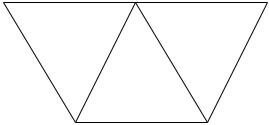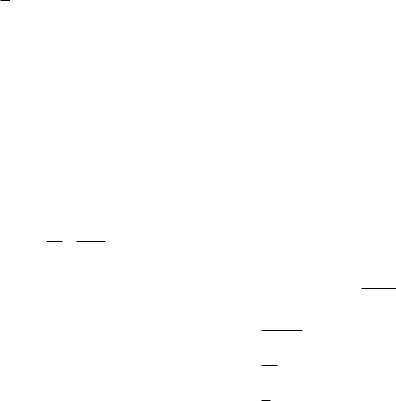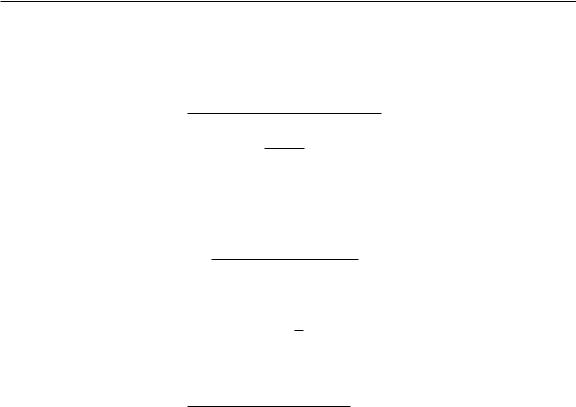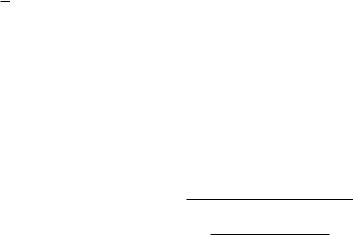
GRE_Math_Bible_eBook
.pdf
Quantitative Comparisons 61
Problem Set F: |
|
|
Easy |
|
|
1. |
Column A |
n is a positive integer |
|
n |
|
2. |
Column A |
0 < x < 1 |
|
x2 |
|
3.Column A
The count of the numbers between 100 and 300 that are divisible by both 5 and 6
Medium
4.Column A
The slope of the line AB
In the rectangular coordinate system shown, points A and E lie on the x-axis, and points B and D lie on the y-axis. Point C is the midpoint of the line AB, and point F is the midpoint of the line DE.
 y-axis
y-axis
B
C(–3, 5)
A |
E |
x-axis
F(3, –5)
Column B
The sum of two integers whose product is n
Column B
x
Column B
The count of the numbers between 100 and 300 that are divisible by either 5 or 6
Column B
The slope of the line DE
D
5. |
Column A |
x = 3.635 • 1016 |
Column B |
|||||||||
|
|
x +1 |
|
|
|
|
|
|
|
x −1 |
|
|
|
|
x −1 |
|
|
|
|
|
|
x +1 |
|||
6. |
Column A |
a + |
|
b |
> 0 |
Column B |
||||||
10 |
||||||||||||
|
|
|
|
|
|
|
|
|
||||
|
|
|
|
b + |
|
a |
|
< 0 |
|
|
|
|
|
|
|
|
10 |
|
|
|
|||||
|
|
|
|
|
|
|
|
|
|
|||
a |
b |

62 GRE Math Bible
7. |
Column A |
|x| + |y| = 2 and x + y = 0. |
Column B |
||||
|
|
x |
|
|
y |
||
8. |
Column A |
(4 – 5x)2 = 1 |
Column B |
||||
|
(4 – 5x) + (4 – 5x)2 |
|
1 |
|
|||
9. |
Column A |
The ratio of x to y is 3 : 4, and the |
Column B |
||||
|
|
x +14 |
|
ratio of x + 7 to y + 7 is 4 : 5. |
|
5 |
|
|
|
|
|
||||
|
|
y +14 |
|
|
6 |
|
|
10. |
Column A |
x and y are two numbers |
Column B |
||||
|
The product of x and y |
|
The product of 80% of x and |
||||
|
|
|
|
|
125% of y |
||
11. |
Column A |
ABC and DEF are right triangles. |
Column B |
||||
|
|
|
|
Each side of ∆ABC is twice the |
|
|
|
|
|
|
|
length of the corresponding side of |
|
|
|
|
The area of ∆DEF |
∆DEF. |
1 |
|
|||
|
|
|
|||||
|
The area of ∆ABC |
|
2 |
|
|||
12. |
Column A |
The nth term of the sequence |
Column B |
||||
|
|
|
|
a1, a2, a3, …, an is defined as |
|
|
|
|
|
|
|
an = –(an – 1). The first term a1 |
|
|
|
|
|
a5 |
equals –1. |
1 |
|
||
|
|
|
|
||||
13. |
Column A |
Everyone who passes the test will |
Column B |
||||
|
|
|
|
be awarded a degree. The |
|
|
|
|
|
|
|
probability that Tom passes the |
|
|
|
|
|
|
|
test is 0.5, and the probability that |
|
|
|
|
|
|
|
John passes the test is 0.4. The |
|
|
|
|
|
|
|
two events are independent of |
|
|
|
|
|
|
|
each other. |
|
|
|
The probability that both Tom and John get the degree
The probability that at least one of them gets the degree
14. |
Column A |
|
|
|
|
|
|
Column B |
|
The difference between two |
|
|
|
|
|
|
179.5° |
|
angles of a triangle |
|
|
|
|
|
|
|
15. |
Column A |
|
2x + 1 > 3x + 2 and |
Column B |
||||
|
x |
|
|
5x + 2 > 4x |
1 |
|||
|
|
|
|
|
|
|
||
Hard |
|
|
|
|
|
|
|
|
16. |
Column A |
l |
= |
m |
= |
n |
= k , where |
Column B |
m + n |
|
|
||||||
|
|
|
n + l |
l + m |
|
|||
k is a real number.
k |
1/3 |

|
|
|
Quantitative Comparisons 63 |
|
17. |
Column A |
The average of a set of six positive |
Column B |
|
|
|
numbers is 30. |
|
|
The average of the numbers in the set after replacing the smallest number in the set with 0
The average of the remaining numbers in the set after removing the smallest number from the set
18.
Column A |
In the figure, ABCD and BECD |
Column B |
Area of parallelogram ABCD |
are parallelograms. |
Area of parallelogram BECD |
|
||
A |
B |
E |
D C
Very Hard
19.Column A
The percentage decrease in the average of the numbers when one of the numbers is dropped from the set
A set has exactly five consecutive |
Column B |
positive integers. |
20% |
|
20.Column A
Percentage of wheat lost in the first three days
A tank is filled with x pounds of |
Column B |
wheat. The tank has a hole at the |
|
bottom and each day 1% of the |
|
wheat is lost from the tank through |
|
the hole. |
3% |
|

64 GRE Math Bible
Answers and Solutions to Problem Set F
Easy
1. Suppose n = 6. Now, the factors of 6 are 6 and 1, and 2 and 3.
In the first case, factors 6 and 1 sum to 7 (= 6 + 1), which is greater than 6 (= Column A). Here, Column B is greater.
In the second case, the factors 2 and 3 sum to 5 (= 2 + 3), which is less than 6 (= Column A). Here, Column A is greater. This is a double case, and therefore the answer is (D).
2. Since 0 < x < 1, we know that x is positive. Now, multiplying both sides of the inequality 0 < x < 1 by x yields
0 < x2 < x
Hence, Column B is greater than Column A, and the answer is (B).
3. The least common multiple of 5 and 6 is the product of the two (since 5 and 6 have no common factors), which is 5 6 = 30. Hence, if a number is divisible by both 5 and 6, it must be a multiple of 30. For example, the numbers 30, 60, 90, … are divisible by both 5 and 6.
Now, if a number is divisible by either 5 or 6, the number must be a multiple of at least one of them. Since there are more multiples of 5 and 6 than there are of 30 between 100 and 300, the count in Column B is greater than the count in Column A.
The answer is (B).
Medium
4. Let the coordinate representations of points A and E (which are on the x-axis) be (a, 0), and (e, 0), respectively. Also, let the coordinates of the points B and D (which are on the y-axis) be (0, b) and (0, d), respectively.
|
|
|
|
|
|
|
|
|
|
|
|
|
|
|
|
|
x |
+ x |
2 |
|
y + y |
2 |
|
|
The formula for the midpoint of two points (x1, y1) and (x2, y2) in a coordinate system is |
1 |
|
, |
1 |
. |
|||||||||||||||||||
|
2 |
|
2 |
|
||||||||||||||||||||
|
|
|
|
|
|
|
|
|
|
|
|
|
|
|
|
|
|
|
|
|
|
|||
a |
+ 0 |
|
0+ |
b |
a |
|
b |
|
= C(−3, 5). Equating the x- and y-coordinates on both |
|||||||||||||||
Hence, the midpoint of AB is |
|
, |
|
= |
|
|
, |
|
|
|
||||||||||||||
|
2 |
2 |
|
|
2 |
|||||||||||||||||||
|
|
|
|
2 |
|
|
|
|
|
|
|
|
|
|
|
|
||||||||
sides yields a/2 = –3 and b/2 = 5. Solving for a and b yields a = –6 and b = 10. |
|
|
|
|
|
|
||||||||||||||||||
|
|
|
|
|
0+ d |
|
|
|
|
|
|
d |
|
|
|
|
|
|
|
|||||
Similarly, the midpoint of DE is e + |
0 , |
|
= |
e |
, |
|
= F(3,− 5). Equating the x- and y-coordinates on |
|||||||||||||||||
2 |
|
|
2 |
|||||||||||||||||||||
|
|
|
2 |
|
|
|
2 |
|
|
|
|
|
|
|
||||||||||
both sides yields e/2 = 3 and d/2 = –5. Solving for e and d yields e = 6 and d = –10.
The slope of a line through two points (x1, y1) and (x2, y2) in a coordinate system is y2 − y1 . x2 − x1
Hence, Column A, which is the slope of AB, equals |
b − 0 |
= − |
b |
= − |
10 |
= |
5. |
|||||||
0− a |
a |
|||||||||||||
|
|
|
|
|
|
|
−6 |
|
3 |
|||||
Column B, which is the slope of DE, equals |
d − 0 |
= − |
d |
= − |
−10 |
= |
5. |
|
|
|||||
0− e |
|
|
|
|
||||||||||
|
|
|
e |
|
6 |
|
|
3 |
|
|
||||
Since both columns equal 5/3, the answer is (C).

Quantitative Comparisons 65
5. Since x is a large positive number, both x + 1 and x – 1 are positive. Hence, we can clear fractions by multiplying both columns by (x + 1)(x – 1), which yields
(x + 1)2 |
(x – 1)2 |
Performing the multiplication yields
x2 + 2x + 1 |
x2 – 2x + 1 |
Subtracting x2 and 1 from both columns yields
2x |
–2x |
Since x is a positive number, Column A is positive and Column B is negative.
Since all positive numbers are greater than all negative numbers, Column A is greater than Column B and the answer is (A).
6. Multiplying the given inequalities by 10 yields
10a + b > 0
10b + a < 0
Multiplying the second inequality by –1 and flipping the direction of the inequality yields
10a + b > 0
–a – 10b > 0
Adding these inequalities yields
9a – 9b > 0
Adding 9b to both sides of the inequality yields 9a > 9b
Finally, dividing both sides of the inequality by 9 yields a > b
Hence, Column A is greater than Column B. The answer is (A).
7. Suppose x = 1 and y = –1. Then |x| + |y| = |1| + |–1| = 1 + 1 = 2, and x + y = 1 + (–1) = 0. Hence, x = 1 and y = –1 is a solution of the system of equations, and here x is greater than y.
Now, suppose x = –1 and y = 1. Then |x| + |y| = |–1| + |1| = 1 + 1 = 2, and x + y = –1 + 1 = 0. Hence, x = –1 and y = 1 is another solution of the system of equations, and here x is less than y.
Thus, we have a double case, and the answer is (D).
8. (4 – 5x)2 equals 1 when either 4 – 5x = –1 or +1. If 4 – 5x equals –1, then (4 – 5x) + (4 – 5x)2 = –1 + 1 = 0; and if 4 – 5x equals 1, then (4 – 5x) + (4 – 5x)2 = 1 + 1 = 2. In the first case, Column A is less than Column B; and in the second case, Column B is less than Column A. Hence, we have a double case, and the answer is (D).

66 GRE Math Bible
9. Forming the two ratios yields |
x |
= |
3 |
and |
x + 7 |
= |
4 |
. Let’s solve this system of equations by the |
|
y |
4 |
y + 7 |
5 |
||||||
|
|
|
|
|
substitution method. Multiplying the first equation by y yields x = 3y/4. Substituting this into the second
|
|
3y |
+ 7 |
|
4 |
|
equation yields |
|
4 |
= |
. Cross-multiplying yields |
||
|
|
|||||
|
y + 7 |
5 |
||||
|
|
|
|
|||
5(3y/4 + 7) = 4(y + 7) 15y/4 + 35 = 4y + 28 15y/4 – 4y = 28 – 35
–y/4 = –7 y = 28
and x = 34y = 3 428 = 3 7 = 21.
x +14
Plugging these values for x and y into the expression in Column A, y +14 , yields
21+14 =
28+14
35 =
42
5 =
6 Column B
Hence, the answer is (C).
10. Column A: The product of x and y is xy.
Column B: 80% of x is |
80 |
|
x = |
4 |
x. |
|
|||||||
100 |
|
|
|
||||||||||
|
|
|
|
|
5 |
|
|
|
|||||
And 125% of y is 125 y = |
|
|
5 |
|
y. |
|
|
|
|
||||
4 |
|
|
|
|
|||||||||
100 |
|
|
|
|
|
|
|
|
|||||
|
|
|
4 |
|
5 |
|
= xy = Column A. |
||||||
The product of the two is |
x |
y |
|||||||||||
|
4 |
||||||||||||
|
|
|
5 |
|
|
||||||||
Hence, the columns are equal, and the answer is (C).

Quantitative Comparisons 67
11. We are given that each side of triangle ABC is twice the length of the corresponding side of triangle DEF. Hence, each leg of triangle ABC must be twice the length of the corresponding leg in triangle DEF. The formula for the area of a right triangle is 1/2 • (product of the measures of the two legs). Hence,
Column A =
The area of ∆DEF =
The area of ∆ABC
|
1 |
|
(leg 1 of ∆DEF)(leg 2 of ∆DEF) |
|||||||||
|
2 |
|||||||||||
|
|
|
|
|
|
|
|
|
|
= |
|
|
|
|
|
|
|
|
|
|
|
|
|
||
|
1 |
|
(leg 1 of ∆ABC)(leg 2 of ∆ABC) |
|||||||||
|
2 |
|
||||||||||
|
|
|
1 |
|
|
|
|
|
|
|
||
|
|
|
|
(leg 1 of ∆DEF)(leg 2 of ∆DEF) |
||||||||
|
|
2 |
|
|||||||||
|
|
|
|
|
|
= |
||||||
|
1 |
|
|
|
|
|
|
|||||
|
|
(2• leg 1 of ∆DEF)(2• leg 2 of ∆DEF) |
||||||||||
|
2 |
|
||||||||||
|
|
1 |
|
|
|
|
|
|
|
|||
|
|
|
|
|
|
|
|
|
||||
|
|
2 |
|
= |
|
|
|
|
||||
|
1 |
(2)(2) |
|
|
||||||||
|
|
|
|
|
|
|||||||
|
2 |
|
|
|||||||||
|
|
|
|
|
|
|
|
|
|
|
|
|
|
1 |
|
|
= |
|
|
|
|
|
|||
|
2 2 |
|
|
|
|
|
||||||
|
|
|
|
|
|
|
|
|||||
|
1 |
|
and this is less than |
1 |
(= Column B) |
|||||||
|
4 |
|
|
|||||||||
|
|
|
|
|
2 |
|
|
|
||||
Hence, the answer is (B).
12. The rule for the sequence is an = –(an – 1). Putting n = 2 and 3 in the rule yields
a2 |
= –(a2 |
–1) = –a1 = –(–1) = 1 |
(given that a1 = –1) |
a3 = –(a3 – 1) = –a2 = –1 |
|
||
Similarly, we get that each even numbered term (when n is even) equals 1 and each odd numbered term (when n is odd) equals –1. Since a5 is an odd numbered term, it equals –1. Hence, Column A equals –1 and is less than 1 (= Column B). The answer is (B).
13.The case of both Tom and John getting a degree is just one of the cases in which at least one of them gets the degree (Column A is one of the cases of Column B). Hence, the probability of the former is less than the probability of the later (Column B is greater). Also, the probability of the remaining case (exactly one of the two passing) is not zero. So, Column A cannot equal Column B. The answer is (B).
14.Suppose the angles of the triangle measure 179.8°, 0.1°, and 0.1°. Then the difference between the first two angles of the triangle is 179.8 – 0.1 = 179.7 > Column B and the difference between the last two angles is 0.1 – 0.1 = 0 < Column B.
Hence, we have a double case, and the answer is (D).
15. We are given the two inequalities
2x + 1 > 3x + 2
5x + 2 > 4x
Subtracting 2x + 2 from both sides of the top inequality and subtracting 4x + 2 from both sides of the bottom inequality yields
–1 > x x > –2
Combining these inequalities yields –1 > x > –2. Since any number between –1 and –2 is less than 1, Column B is greater than Column A. The answer is (B).

68 GRE Math Bible
Hard |
|
|
|
|
|
|
16. The given equation is |
l |
= |
m |
= |
n |
= k . Forming the three equations yields l = (m + n)k, m = |
m + n |
|
|
||||
|
|
n + l |
l + m |
|||
(n + l)k, n = (l + m)k. Summing these three equations yields
l + m + n = (m + n)k + (n + l)k + (l + m)k
=k[(m + n) + (n + l) + (l + m)]
=k(m + n + n + l + l + m)
=k(2m + 2n + 2l)
=2k(m + n + l)
1 = 2k |
by canceling m + n + l from each side |
1/2 = k |
|
Hence, Column A equals 1/2. Since 1/2 is greater than 1/3, Column A is greater than Column B, and the answer is (A).
17. Let a, b, c, d, e, and f be the numbers in the set, and let f be the smallest number in the set.
When the smallest number (f) in the set is replaced by 0, the numbers in the set are a, b, c, d, e, and 0.
Column A equals the average of these six numbers, which equals |
a + b + c + d + e + 0 |
= |
a + b + c + d + e |
. |
|
6 |
6 |
||||
|
|
|
Instead, if the smallest number in the set is removed, the remaining numbers in the set would be a, b, c, d, and e. Now there are only 5 numbers in the set. Hence, Column B, which equals the average of the
remaining numbers (five numbers) in the set, equals a + b + c + d + e .
5
Since all the numbers in the set are positive (given), the sum of the five numbers a + b + c + d + e is also positive. Note that dividing a positive number by 5 yields a greater result than dividing it by 6. Hence,
|
a + b + c + d + e |
is greater than |
a + b + c + d + e |
. Thus, Column B is greater than Column A, and the answer |
|
5 |
6 |
||||
|
|
||||
is (B). |
|
|
|
||
18. We know that a diagonal of a parallelogram cuts the parallelogram into two triangles of equal area. Since BD is a diagonal of parallelogramABCD, the area of the parallelogram equals twice the area of either of the two equal triangles ∆ABD or ∆DBC. Hence, Column A = 2(area of ∆DBC).
Similarly, since BC is a diagonal of parallelogram BECD, the area of the parallelogram BECD is 2(area of ∆DBC).
Thus, both columns equal 2(area of ∆DBC), and the answer is (C).

Quantitative Comparisons 69
Very Hard
19. The average of the five consecutive positive integers, say, a, a + 1, a + 2, a + 3, and a + 4 is
a + (a +1)+ (a + 2)+ (a + 3)+ (a + 4) =
5
5a +10 =
5 a + 2
The average decrease is a maximum when the a + 4, the average of the remaining numbers a,
greatest number in the set is dropped. Hence, after dropping a + 1, a + 2, and a + 3 is
a + (a +1)+ (a + 2)+ (a + 3) =
4
4a + 6 =
4 a + 23
The percentage decrease in the average is
Old Average – New Average ×100 =
Old Average
|
|
|
|
3 |
|
|||
(a + 2)− a |
+ |
|
||||||
|
||||||||
|
|
|
2 |
|
×100 = |
|||
a + 2 |
|
|
||||||
|
|
|
|
|||||
|
1 |
|
|
|
|
|
||
|
2 |
|
×100 |
|||||
a + 2 |
||||||||
|
|
|
|
|
||||
The percentage is a maximum when a takes the minimum possible value. Since a is a positive integer, the minimum value of a is 1. Hence, the maximum possible percentage equals
1 |
|
|
|
|
2 |
|
|
×100 = |
|
1+ 2 |
||||
|
||||
1 |
|
|
|
|
2 |
|
×100 = |
||
3 |
|
|||
|
|
|
||
1 |
|
|
×100 = |
|
2 3 |
|
|||
|
|
|||
100 |
= |
|||
6 |
|
|
|
|
16.66%
Hence, the maximum possible value of Column A is 16.66%, which is less than Column B. Hence, the answer is (B).

70 GRE Math Bible
20. We are given that each day 1% of the remaining wheat in the tank is lost. The initial content in the tank is x pounds. By the end of the first day, the content remaining is
(Initial content)(1 – Loss percent/100) = x(1 – 1/100) = 0.99x
Similarly, the content remaining after the end of the second day is 0.99x(1 – 1/100) = (0.99)(0.99)x; and by the end of the third day, the content remaining is (0.99)(0.99)(0.99)x. Hence, Column A, which equals the net loss percentage in the three consecutive days, is
Initial content – Final content •100 =
Final content
x − 0.99• 0.99• 0.99x •100 = x
100 − 99(0.99)(0.99) ≈ 2.9, which is less than 3
Hence, Column A < Column B and the answer is (B).
